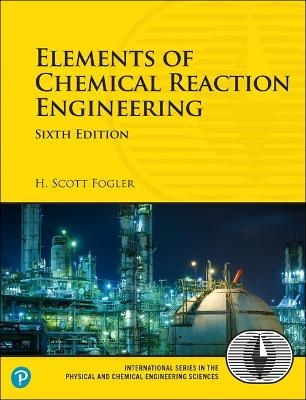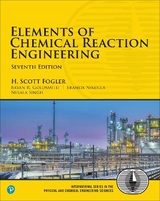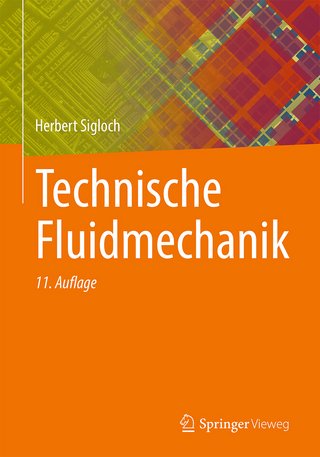
Elements of Chemical Reaction Engineering
Pearson (Verlag)
978-0-13-548622-1 (ISBN)
- Titel erscheint in neuer Auflage
- Artikel merken
For decades, H. Scott Fogler's Elements of Chemical Reaction Engineering has been the world's dominant chemical reaction engineering text. This Sixth Edition and integrated Web site deliver a more compelling active learning experience than ever before. Using sliders and interactive examples in Wolfram, Python, POLYMATH, and MATLAB, students can explore reactions and reactors by running realistic simulation experiments.
Writing for today's students, Fogler provides instant access to information, avoids extraneous details, and presents novel problems linking theory to practice. Faculty can flexibly define their courses, drawing on updated chapters, problems, and extensive Professional Reference Shelf web content at diverse levels of difficulty.
The book thoroughly prepares undergraduates to apply chemical reaction kinetics and physics to the design of chemical reactors. And four advanced chapters address graduate-level topics, including effectiveness factors. To support the field's growing emphasis on chemical reactor safety, each chapter now ends with a practical safety lesson.
Updates throughout the book reflect current theory and practice and emphasize safety
New discussions of molecular simulations and stochastic modeling
Increased emphasis on alternative energy sources such as solar and biofuels
Thorough reworking of three chapters on heat effects
Full chapters on nonideal reactors, diffusion limitations, and residence time distribution
About the Companion Web Site (umich.edu/~elements/6e/index.html)
Complete PowerPoint slides for lecture notes for chemical reaction engineering classes
Links to additional software, including POLYMATH™, MATLAB™, Wolfram Mathematica™, AspenTech™, and COMSOL™
Interactive learning resources linked to each chapter, including Learning Objectives, Summary Notes, Web Modules, Interactive Computer Games, Solved Problems, FAQs, additional homework problems, and links to Learncheme
Living Example Problems -- unique to this book -- that provide more than 80 interactive simulations, allowing students to explore the examples and ask "what-if" questions
Professional Reference Shelf, which includes advanced content on reactors, weighted least squares, experimental planning, laboratory reactors, pharmacokinetics, wire gauze reactors, trickle bed reactors, fluidized bed reactors, CVD boat reactors, detailed explanations of key derivations, and more
Problem-solving strategies and insights on creative and critical thinking
Register your book for convenient access to downloads, updates, and/or corrections as they become available. See inside book for details.
H. Scott Fogler is the Ame and Catherine Vennema Professor of Chemical Engineering and the Arthur F. Thurnau Professor at the University of Michigan. He has been research advisor to forty-five Ph.D. students, and has more than two hundred thirty-five refereed publications. He was 2009 President of the American Institute of Chemical Engineers. Fogler has chaired ASEE's Chemical Engineering Division, served as director of the American Institute of Chemical Engineers, and earned the Warren K. Lewis Award from AIChE for contributions to chemical engineering education. He has received the Chemical Manufacturers Association's National Catalyst Award and the 2010 Malcom E. Pruitt Award from the Council for Chemical Research.
Introduction xix
About the Author xxxiii
Chapter 1: Mole Balances 1
1.1 The Rate of Reaction, –r_A 4
1.2 The General Mole Balance Equation (GMBE) 8
1.3 Batch Reactors (BRs) 10
1.4 Continuous-Flow Reactors 12
1.5 Industrial Reactors 24
1.6 And Now . . . A Word from Our Sponsor -- Safety 1 (AWFOS - S1 Safety) 25
Chapter 2: Conversion and Reactor Sizing 35
2.1 Definition of Conversion 36
2.2 Batch Reactor Design Equations 36
2.3 Design Equations for Flow Reactors 39
2.4 Sizing Continuous-Flow Reactors 42
2.5 Reactors in Series 51
2.6 Some Further Definitions 62
2.7 And Now . . . A Word from Our Sponsor -- Safety 2 (AWFOS - S2 The NFPA Diamond) 66
Chapter 3: Rate Laws 75
3.1 Basic Definitions 76
3.2 The Rate Law 78
3.3 The Reaction-Rate Constant 89
3.4 Molecular Simulations 100
3.5 Present Status of Our Approach to Reactor Sizing and Design 103
3.6 And Now . . . A Word from Our Sponsor -- Safety 3 (AWFOS - S3 The GHS Diamond) 104
Chapter 4: Stoichiometry 117
4.1 Batch Reactors (BRs) 119
4.2 Flow Systems 125
4.3 Reversible Reactions and Equilibrium Conversion 138
4.4 And Now . . . A Word from Our Sponsor -- Safety 4 (AWFOS - S4 The Swiss Cheese Model) 143
Chapter 5: Isothermal Reactor Design: Conversion 155
5.1 Design Structure for Isothermal Reactors 156
5.2 Batch Reactors (BRs) 160
5.3 Continuous-Stirred Tank Reactors (CSTRs) 168
5.4 Tubular Reactors 178
5.5 Pressure Drop in Reactors 185
5.6 Synthesizing the Design of a Chemical Plant 208
5.7 And Now . . . A Word from Our Sponsor -- Safety 5 (AWFOS - S5 A Safety Analysis of the Incident Algorithm) 210
Chapter 6: Isothermal Reactor Design: Moles and Molar Flow Rates 229
6.1 The Moles and Molar Flow Rate Balance Algorithms 230
6.2 Mole Balances on CSTRs, PFRs, PBRs, and Batch Reactors 230
6.3 Application of the PFR Molar Flow Rate Algorithm to a Microreactor 234
6.4 Membrane Reactors 239
6.5 Unsteady-State Operation of Stirred Reactors 248
6.6 Semibatch Reactors 249
6.7 And Now . . . A Word from Our Sponsor -- Safety 6 (AWFOS - S6 The BowTie Diagram) 256
Chapter 7: Collection and Analysis of Rate Data 269
7.1 The Algorithm for Data Analysis 270
7.2 Determining the Reaction Order for Each of Two Reactants Using the Method of Excess 272
7.3 Integral Method 273
7.4 Differential Method of Analysis 277
7.5 Nonlinear Regression 284
7.6 Reaction-Rate Data from Differential Reactors 290
7.7 Experimental Planning 297
7.8 And Now . . . A Word from Our Sponsor -- Safety 7 (AWFOS - S7 Laboratory Safety) 297
Chapter 8: Multiple Reactions 309
8.1 Definitions 310
8.2 Algorithm for Multiple Reactions 313
8.3 Parallel Reactions 316
8.4 Reactions in Series 325
8.5 Complex Reactions 335
8.6 Membrane Reactors to Improve Selectivity in Multiple Reactions 343
8.7 Sorting It All Out 348
8.8 The Fun Part 348
8.9 And Now . . . A Word from Our Sponsor -- Safety 8 (AWFOS - S8 The Fire Triangle) 349
Chapter 9: Reaction Mechanisms, Pathways, Bioreactions, and Bioreactors 367
9.1 Active Intermediates and Nonelementary Rate Laws 368
9.2 Enzymatic Reaction Fundamentals 377
9.3 Inhibition of Enzyme Reactions 391
9.4 Bioreactors and Biosynthesis 399
9.5 And Now . . . A Word from Our Sponsor -- Safety 9 (AWFOS - S9 Process Safety Triangle) 422
Chapter 10: Catalysis and Catalytic Reactors 441
10.1 Catalysts 441
10.2 Steps in a Catalytic Reaction 447
10.3 Synthesizing a Rate Law, Mechanism, and Rate-Limiting Step 463
10.4 Heterogeneous Data Analysis for Reactor Design 479
10.5 Reaction Engineering in Microelectronic Fabrication 490
10.6 Model Discrimination 493
10.7 Catalyst Deactivation 496
10.8 Reactors That Can Be Used to Help Offset Catalyst Decay 507
10.9 And Now . . . A Word from Our Sponsor -- Safety 10 (AWFOS - S10 Exxon Mobil Torrance Refinery Explosion Involving
a Straight-Through Transport Reactor [STTR]) 519
Chapter 11: Nonisothermal Reactor Design: The Steady-State Energy Balance and Adiabatic PFR Applications 541
11.1 Rationale 542
11.2 The Energy Balance 543
11.3 The User-Friendly Energy Balance Equations 551
11.4 Adiabatic Operation 557
11.5 Adiabatic Equilibrium Conversion 566
11.6 Reactor Staging with Interstage Cooling or Heating 571
11.7 Optimum Feed Temperature 575
11.8 And Now . . . A Word from Our Sponsor -- Safety 11 (AWFOS - S11 Acronyms) 579
Chapter 12: Steady-State Nonisothermal Reactor Design: Flow Reactors with Heat Exchange 591
12.1 Steady-State Tubular Reactor with Heat Exchange 592
12.2 Balance on the Heat-Transfer Fluid 595
12.3 Examples of the Algorithm for PFR/PBR Design with Heat Effects 598
12.4 CSTR with Heat Effects 619
12.5 Multiple Steady States (MSS) 630
12.6 Nonisothermal Multiple Chemical Reactions 637
12.7 Radial and Axial Temperature Variations in a Tubular Reactor 652
12.8 And Now . . . A Word from Our Sponsor -- Safety 12 (AWFOS - S12 Safety Statistics) 652
Chapter 13: Unsteady-State Nonisothermal Reactor Design 681
13.1 The Unsteady-State Energy Balance 682
13.2 Energy Balance on Batch Reactors (BRs) 684
13.3 Batch and Semibatch Reactors with a Heat Exchanger 700
13.4 Nonisothermal Multiple Reactions 711
13.5 And Now . . . A Word from Our Sponsor -- Safety 13 (AWFOS - S13 Safety Analysis of the T2 Laboratories Incident) 723
Chapter 14: Mass Transfer Limitations in Reacting Systems 739
14.1 Diffusion Fundamentals 740
14.2 Binary Diffusion 744
14.3 Modeling Diffusion with Chemical Reaction 748
14.4 The Mass Transfer Coefficient 750
14.5 Mass Transfer to a Single Particle 752
14.6 The Shrinking Core Model 758
14.7 Mass Transfer-Limited Reactions in Packed Beds 763
14.8 Robert the Worrier 766
14.9 What If . . . ? (Parameter Sensitivity) 770
14.10 And Now . . . A Word from Our Sponsor -- Safety 14 (AWFOS - S14 Sugar Dust Explosion) 778
Chapter 15: Diffusion and Reaction 791
15.1 Diffusion and Reactions in Homogeneous Systems 792
15.2 Diffusion and Reactions in Spherical Catalyst Pellets 793
15.3 The Internal Effectiveness Factor 802
15.4 Falsified Kinetics 809
15.5 Overall Effectiveness Factor 811
15.6 Estimation of Diffusion- and Reaction-Limited Regimes 816
15.7 Mass Transfer and Reaction in a Packed Bed 817
15.8 Determination of Limiting Situations from Reaction-Rate Data 823
15.9 Multiphase Reactors in the Professional Reference Shelf 824
15.10 Fluidized Bed Reactors 826
15.11 Chemical Vapor Deposition (CVD) 826
15.12 And Now . . . A Word from Our Sponsor -- Safety 15 (AWFOS - S15 Critical Thinking Questions Applied to Safety) 826
Chapter 16: Residence Time Distributions of Chemical Reactors 843
16.1 General Considerations 844
16.2 Measurement of the RTD 846
16.3 Characteristics of the RTD 853
16.4 RTD in Ideal Reactors 860
16.5 PFR/CSTR Series RTD 866
16.6 Diagnostics and Troubleshooting 869
16.7 And Now . . . A Word from Our Sponsor -- Safety 16 (AWFOS - S16 Critical Thinking Actions) 876
Chapter 17: Predicting Conversion Directly from the Residence Time Distribution 887
17.1 Modeling Nonideal Reactors Using the RTD 888
17.2 Zero Adjustable Parameter Models 890
17.3 Using Software Packages Such as Polymath to Find Maximum Mixedness Conversion 907
17.4 Tanks-in-Series One Parameter Model, n 910
17.5 RTD and Multiple Reactions 912
17.6 And Now . . . A Word from Our Sponsor -- Safety 17 (AWFOS - S17 Brief Case History on an Air Preheater) 917
Chapter 18: Models for Nonideal Reactors 929
18.1 Some Guidelines for Developing Models 930
18.2 Flow and Axial Dispersion of Inert Tracers in Isothermal Reactors 933
18.3 Flow, Reaction, and Axial Dispersion 937
18.4 Flow, Reaction, and Axial Dispersion in Isothermal Laminar-Flow Reactors and Finding Meno 941
18.5 Tanks-in-Series Model versus Dispersion Model 951
18.6 Numerical Solutions to Flows with Dispersion and Reaction 952
18.7 Nonisothermal Flow with Radial and Axial Variations in a Tubular Reactor 956
18.8 Two-Parameter Models -- Modeling Real Reactors with Combinations of Ideal Reactors 964
18.9 And Now . . . A Word from Our Sponsor -- Safety 18 (AWFOS - S18 An Algorithm for Management of Change (MoC)) 974
Appendix A: Numerical Techniques 991
A.1 Useful Integrals in Chemical Reactor Design 991
A.2 Equal-Area Graphical Differentiation 992
A.3 Solutions to Differential Equations 994
A.4 Numerical Evaluation of Integrals 995
A.5 Semi-Log Graphs 997
A.6 Software Packages 997
Appendix B: Ideal Gas Constant and Conversion Factors 999
Appendix C: Thermodynamic Relationships Involving the Equilibrium Constant 1003
Appendix D: Software Packages 1009
D.1 Polymath 1009
D.2 Wolfram 1010
D.3 Python 1011
D.4 MATLAB 1011
D.5 Excel 1011
D.6 COMSOL (http://www.umich.edu/~elements/6e/12chap/comsol.html) 1012
D.7 Aspen 1013
D.8 Visual Encyclopedia of Equipment -- Reactors Section 1013
D.9 Reactor Lab 1013
Appendix E: Rate-Law Data 1015
Appendix F: Nomenclature 1017
Appendix G: Open-Ended Problems 1021
G.1 Chem-E-Car 1021
G.2 Effective Lubricant Design 1021
G.3 Peach Bottom Nuclear Reactor 1021
G.4 Underground Wet Oxidation 1022
G.5 Hydrodesulfurization Reactor Design 1022
G.6 Continuous Bioprocessing 1022
G.7 Methanol Synthesis 1022
G.8 Cajun Seafood Gumbo 1022
G.9 Alcohol Metabolism 1023
G.10 Methanol Poisoning 1024
G.11 Safety 1024
Appendix H: Use of Computational Chemistry Software Packages 1025
H.1 Computational Chemical Reaction Engineering 1025
Appendix I: How to Use the CRE Web Resources 1027
I.1 CRE Web Resources Components 1027
Index 1029
| Erscheinungsdatum | 15.01.2019 |
|---|---|
| Reihe/Serie | International Series in the Physical and Chemical Engineering Sciences |
| Sprache | englisch |
| Maße | 198 x 252 mm |
| Gewicht | 1610 g |
| Themenwelt | Naturwissenschaften ► Chemie ► Technische Chemie |
| Technik ► Umwelttechnik / Biotechnologie | |
| ISBN-10 | 0-13-548622-X / 013548622X |
| ISBN-13 | 978-0-13-548622-1 / 9780135486221 |
| Zustand | Neuware |
| Informationen gemäß Produktsicherheitsverordnung (GPSR) | |
| Haben Sie eine Frage zum Produkt? |
aus dem Bereich



